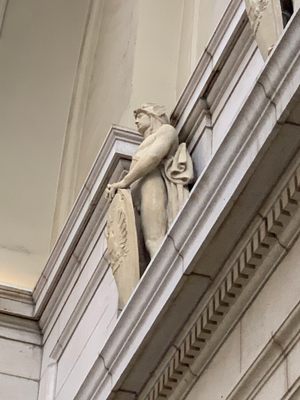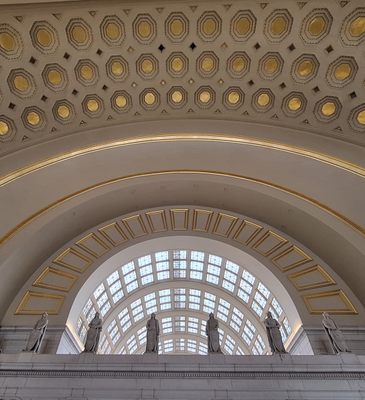About
As travelers pass through the Main Hall of Union Station in Washington, D.C., they walk beneath the sandaled feet of 46 cast plaster Roman legionnaires.
Renowned architect Daniel H. Burnham designed Union Station, which opened on October 27, 1907. As part of Burnham’s plan for the design of the National Mall, its grand, neoclassical style was based upon the designs of ancient Roman baths and the Arch of Constantine.
In 1906, artist and sculptor Louis Saint-Gaudens was selected to create statues for the train station. In keeping with the architectural design, he envisioned Roman soldiers placed on ledges overlooking the Main Hall. Saint-Gaudens specifically inquired whether the Fine Arts Commission overseeing the station’s design elements wanted the Roman legionnaires to be historically accurate. They told him that they most certainly did. When Saint-Gaudens presented a prototype soldier to the commission, they were shocked and horrified to discover that the statue was naked from the waist down.
Although the statute did not have detailed genitalia, there was a bulge at the crotch that could not be mistaken for anything other than naughty bits. It was a degree of historical and anatomical accuracy to which female travelers visiting Union Station could not be subjected. The artist and the commission ultimately decided that each legionnaire would hold a large shield that covered his front from feet to waist.
The 46 Roman legionnaire statutes were completed and installed in Union Station in 1913. There is one to represent each state of the union at the time of the station’s 1907 opening. Thirty-six of the statues are on ledges around the Main Hall’s circumference, and 10 stand in the loggia arches. The hand-carved figures are made from hollow cast plaster with a sand finish. The statues’ model was Helmus Andrews, a student from California, and each legionnaire bears his face.
Half of the legionnaires are completely naked behind their strategically-placed shields and wear floor-length capes concealing their backsides, including their presumably bare buttocks. The other soldiers wear pleated tunics ending at their hips. Eagles decorate the legionnaires' helmets and shields. The nude legionnaires pose with both hands on their shields, and the partially-dressed soldiers use only one hand.
Despite attempts to cover the statues, curious and intrepid visitors to Union Station can still peek behind some of the shields and get a glimpse of the soldierly “equipment” censored over a century ago.
Related Tags
Know Before You Go
Washington Union Station is open to ticketed passengers 24 hours a day, seven days a week. It's closed to the public from 12:00 a.m. to 5:00 a.m.
Community Contributors
Added By
Published
August 19, 2020
Sources
- http://mallhistory.org/items/show/128
- https://boundarystones.weta.org/2014/11/12/how-union-station-was-saved-1980s
- https://www.greatamericanstations.com/stations/washington-union-station-dc-was/
- https://www.planning.org/greatplaces/spaces/2008/unionstation.htm
- http://heydaydc.com/2014/06/union-station-roman-legionnaires/
- https://savingplaces.org/places/union-station/updates/first-four-legionnaires-in-the-union-stations-west-hall-restored#.XzFLLRNKjBI


























































